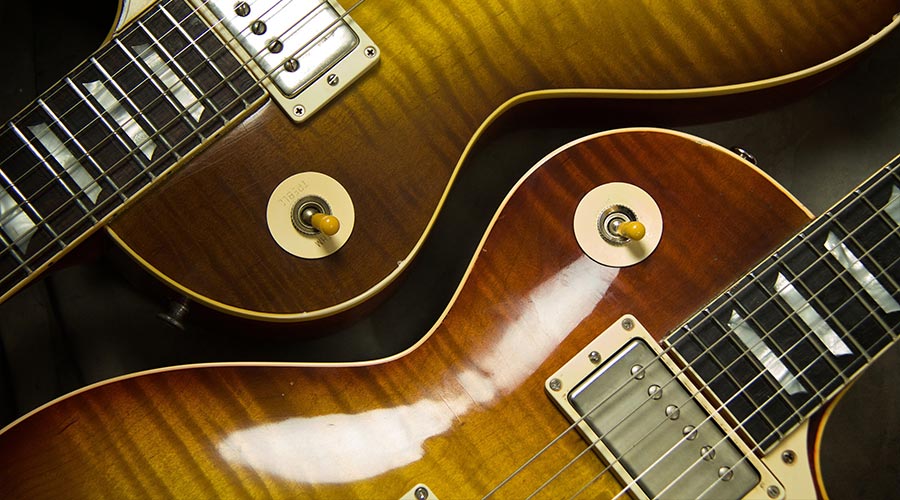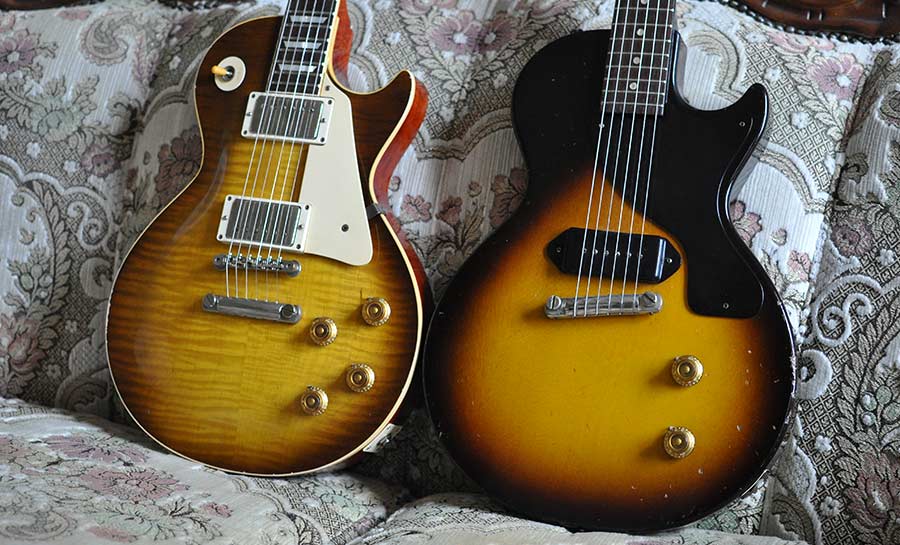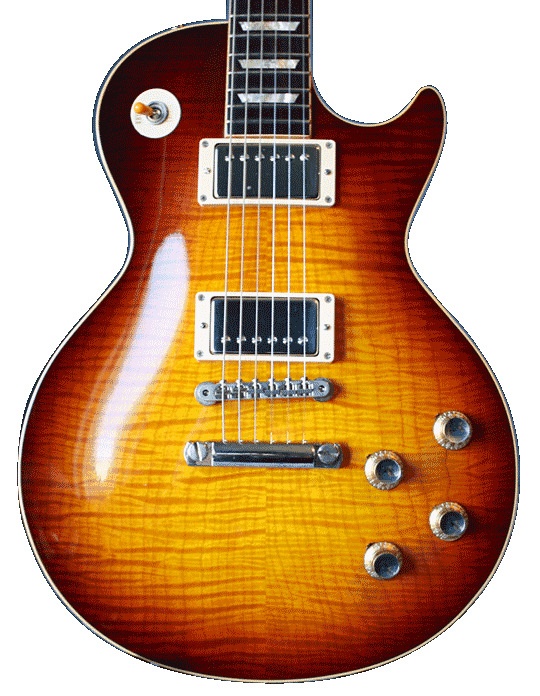
When I first heard about Les Paul copies, I was floored.
Why would someone take such an iconic, nearly perfect guitar and recreate it? Further, why on earth would anyone want to play a copy over the real thing?
Believe it or not, the reasons are quite convincing.
Gibson Les Paul vs Les Paul Copy: The Differences
Definitively summarizing every specific difference between Gibson Les Pauls and their copies wouldn’t take hours—it would take days. The simple truth is that not all Les Paul copies are created equal; each copy is created for its own purpose, with specific tonal, aesthetic, and budgetary goals in mind. Because of this, there is no single objective list of the differences between copies and real Gibsons.
That being said, here are some common areas where genuine Les Pauls can differ from their copies, and how these differences change the character of the guitar:
- Wood type (tone)
- Body and headstock styles (aesthetics and tone)
- Hardware metal type (tone)
- Pickups and wiring harness (tone)
- Guitar size and weight (playability)
Why Are Gibson Les Pauls Copied?
As it turns out, the motives behind making Les Paul copies actually do make some sense.
There are three main reasons to copy a Les Paul: 1) to enhance or achieve a particular sound; 2) to customize aesthetics; 3) to meet a certain buyer budget.
It’s important to note that while we’ve broken these down into three separate categories, usually Les Pauls are copied due to a combination of all these reasons.
Sound
Sound is undoubtedly the biggest driver behind the creation of Les Paul copies. While the Les Paul is known for its versatility, some advanced musicians have developed extremely specific tastes and tonal preferences.
With a customized Les Paul copy, the desirable aspects of an original Gibson model can be mostly preserved, and additional tonal requirements can be met.
For electric guitars, wood type, body style, and internal components (like pickups and wiring harness) are the primary sculptors of the sonic landscape. In particular, they impact tone, volume and sustain.
Later on in this article, we will examine three of the most popular Les Paul copies, going into more detail about how exactly these changes affect the guitar’s sound.
Aesthetics
The Gibson Les Paul is elegantly classic, quintessentially American; and this is one of the reasons it is so beloved in the musical world.
But, for obvious reasons, not all guitarists want this to be their look. In our article about what makes the Les Paul so special, we talked about its unique ability to be used in almost any genre. Take heavy metal as an example: many of these guitarists don’t want to sacrifice the Les Paul’s performance, but want a darker, more modern-looking guitar in order to complement the rest of their act.
Queue a custom-made, jet-black Les Paul copy to make even the most pious metalheads stumble in temptation.
Budget
A much less exciting reason to make a Les Paul copy, buyer budget is an important factor nonetheless. With a new Les Paul Standard going for around $2,800 from Gibson, it’s clear that not all guitarists (especially beginners) are able to take this plunge.
Usually due to international manufacturing and cheaper materials, some Les Paul copies do a wonderful job of providing the buyer with a comparable sound for a much cheaper price tag.
Types of Les Paul Copies

At this point, we can at the very least justify the existence of Les Paul copies.
But now let’s take a deeper look into how the sonic, aesthetic, and budgetary considerations actually play out in three of the most common types of Les Paul copies: Heritage Guitars, Epiphone, and Made in Japan (MIJ) Les Pauls.
Heritage Les Pauls
Maybe not-so-shockingly, Heritage Guitars was founded in 1985 by three former Gibson employees. Since it’s a much smaller operation than Gibson, Heritage has always put an emphasis on careful, handmade guitar construction.
By far the most famous Heritage guitar is the H-150 solid body. It is blatantly obvious to even the most casual guitarist that this model was created unashamedly as a Les Paul copy. What are the benefits of using an H-150? Proponents cite a higher general build quality and better body construction, with resulting tonal changes (or perhaps improvements).
Key Differences
- The H-150 is still made in the legendary Kalamazoo factory and is known to be more consistent in overall quality, as total guitar output from Heritage is far lower than that of Gibson. This results in a more carefully crafted guitar that will need less repairs and can last longer.
- While the H-150’s body is always constructed with a solid maple top and one-piece mahogany back just like the the Gibson Les Paul, the tools and wood sources used are different. Hardcore tone geeks will tell you that, though the difference is subtle, tonewood does play a role in how a guitar sounds.
- Perhaps the most noticeable difference on this list, the H-150 has a more streamlined headstock than the Gibson Les Paul. This change was made primarily for aesthetic reasons, though some guitarists hold that the smaller headstock makes tuning easier, and even minimally affects tone.
- The H-150 is fitted with two Seymour Duncan ‘59 pickups, while the Gibson Les Paul features two Burstbucker Pros. Both pickups are humbuckers designed to produce thick, powerful tones while retaining some of the original, vintage Les Paul sound.
Takeaways
Out of the three Les Paul copies discussed in this article, the Heritage Guitars H-150 is arguably the closest to the actual Gibson Les Paul. Differences are small, and they affect the guitar’s performance and tone only minimally.
The H-150 has a higher build quality and subsequently different (some would say better) tonal qualities. Pricing starts at $2,600.
Epiphone Les Pauls
Believe it or not, Epiphone was founded way back in 1873, in the country of Turkey. Come 1957, Epiphone was purchased by Gibson; that’s why the company is legally permitted to call its copy a Les Paul—because, in a sense, it is!
The Epiphone Les Paul is well known for being a budget alternative to the original Gibson Les Paul, with the Standard model going for around $900. Undoubtedly, guitar quality suffers as a result—but this doesn’t mean you should immediately cross it off your list.
Key Differences
- While the Gibson and Epiphone Les Pauls both use mahogany and maple wood, the specific species used differs between the two. By and large, the wood used in the Gibson Les Paul is of a much higher quality than that used in the Epiphone. As a result, the Epiphone’s tone deviates from the iconic Gibson tone—this is not necessarily a bad thing, but it is important to note.
- The Epiphone Les Paul’s body is usually constructed with as many as five or more separate pieces of wood glued together. Compare this with Gibson’s one or two (sometimes three) pieces. It’s clear that the Epiphone’s tone and sustain will suffer as a result.
- The Epiphone Les Paul is lighter than the Gibson Les Paul by about one pound, which can increase playability depending on the guitarist. This is especially true for certain models that have chambered or weight relieved bodies.
- The overall higher quality of materials, including hardware and internal components, used in the Gibson Les Paul gives it a longer lifespan than the Epiphone Les Paul—it also requires fewer routine repairs.
- Many of the Epiphone guitars, including the Les Paul model, is made in other countries like China. Gibsons are still made in the United States.
Takeaways
The Epiphone Les Paul is an excellent budget alternative to the Gibson Les Paul. Aesthetically, it’s difficult to tell the difference between these two guitars, and to a beginner guitarist, the general playability and tones of each guitar would seem quite similar. That is, until you look at the headstock.
Still, there’s a reason the Epiphone Les Paul is almost $2,000 cheaper than the Gibson; the lower quality of materials used inevitably affects tone and performance in a negative way.
Made In Japan Les Pauls
A ‘Made in Japan’ (MIJ) Les Paul is not a specific model. The term refers broadly to any Les Paul copy that was made (you guessed it!) in Japan. Edwards, Tokai, and Greco are examples of companies that produce MIJ Les Pauls.
These MIJ Les Paul copies are actually quite popular in the guitarist scene, as they offer some of the best value-for-money Les Paul copies in the world. As can be expected, each brand offers its own unique take on the iconic Gibson.
Key Differences
- The Edwards Les Paul copy is, aesthetically speaking, nearly identical to the Gibson. Of course, differences in materials result in subtly different tones—but overall, the Edwards Les Paul copy is known for exceptionally high build quality and strikingly similar tones and playability compared to the Gibson.
- Tokai has long taken pride in the unbelievable accuracy of its Les Paul copies, to the point where Tokai copies have themselves been copied by other companies. In particular, the Tokai Love Rock model is revered as one of the highest-quality Les Paul copies.
- Greco is a company that has been known to replicate specific Les Pauls down to the exact year. Greco’s Les Paul copies aren’t always known to be the most consistent; they tend to fall on a spectrum, with some performing exceptionally and others not so much. Neck types, material types, and finish thicknesses vary between the different models, each with corresponding sonic differences. Many Greco Les Paul copies fall more cleanly into the category of Les Paul replicas—more on that in a below section.
Takeaways
While quality tends to vary from guitar to guitar, it is well known within the guitarist ‘inner circle’ that the above companies have created some of the most superb Les Paul copies, many with exceptionally high degrees of similarity to some original Gibson models.
Overall, these MIJ Les Paul copies provide what are perhaps some of the best value-for-money copies on the market today.
Guitarists That Play Les Paul Copies
Here is where things really got interesting for me.
As it turns out, a Les Paul copy is not just a ‘hack’ solution for cheap guitarists looking to cut corners and save money. Check out these famous guitarists who use Les Paul copies, and prepare to be surprised.
- Since we just finished talking about MIJ Les Paul copies, it makes sense to start off with Billy Gibbons, the legendary bearded ZZ Top guitarist. Billy does play a real Gibson Les Paul, but he regularly swaps it out for his Tokai Les Paul copy. Since someone as famous as Billy Gibbons most likely isn’t strapped for cash, it’s clear that he plays this guitar because he prefers it in some ways to his Gibson.
- Slash, lead guitarist and soloist for Guns N’ Roses, plays a 1959 Les Paul Standard replica designed by luthier Kris Derrig (check out the below section for the technical difference between a copy and a replica). Slash really loves this guitar; he played it on nearly every Guns N’ Roses record, as well as nearly every one of his solo albums.
- When compared to the others on this list, the name of Jared James Nichols probably doesn’t ring as many bells. A semi-famous artist known for playing with no pick, Nichols primarily plays an Epiphone Les Paul. Given the fact that he partnered with Gibson to create his own signature model of the Epiphone Les Paul, it’s pretty obvious that he plays an Epiphone because he likes it, not because he’s trying to save money.
Les Paul Copies vs Les Paul Replicas
As mentioned above, Slash technically plays a Les Paul replica, not a Les Paul copy. What’s the difference? Basically, it’s a matter of the specificity and intent of duplication.
A Les Paul replica is an individual guitar that was created for the express purpose of perfectly duplicating an existing Gibson Les Paul, down to the exact model and year. To take Slash as an example, every minute detail of his Les Paul replica was modeled exactly after the most-sought-after Gibson 1959 Les Paul Standard.
On the other hand, a Les Paul copy refers to one out of an entire line of guitars, all manufactured to imitate the look, feel, and features of the Les Paul line in general. As we have seen, some Les Paul copies have striking degrees of similarity to the original Gibsons, while others tend to deviate more.
No Gibson replicas or copies are to be confused with the infamous Chibson line of guitars, which are quite literally illegal counterfeit Gibsons. These differ from the copies and replicas discussed in this article in that they actually use the Gibson name and branding with the intent of deceiving the buyer.
The Final Verdict: Are Les Paul Copies Worth Your Time and Money?
When I first learned about Les Paul copies, I wondered why anyone would trouble themselves with buying one—much less manufacturing one!
But because some of these copies are of such high quality, and some come with a much lower price tag, I’ve lately been turning over the opposite question: are real Gibsons even worth it?
The answer? It’s up to you.
Share your thoughts in our forum! 💬
👉 Introduce yourself and show off your Les Paul and other gear.
Frequently Asked Questions
What guitar sounds most like a Les Paul?
In terms of sound, the Heritage Guitars H-150 is arguably the closest to a real Gibson Les Paul. Other contenders include the Made in Japan Les Paul copies, from brands like Edwards, Tokai and Greco.
Who else makes Les Paul guitars?
A stunning quantity of Les Paul copies have been created over the years, by companies such as Heritage Guitars, Epiphone, Edwards, Tokai, and Greco. However, Epiphone is the only company besides Gibson that can be said to produce real Les Pauls.
Is an Epiphone Les Paul a real Les Paul?
Because Epiphone has been owned by Gibson since 1957, the Epiphone Les Paul is considered to be a real Les Paul. However, that does not mean it sounds or plays the same as a Gibson.
Are Epiphone Les Pauls as good as Gibsons?
The Epiphone Les Paul uses cheaper materials than the Gibson model, and they’re typically made in China. As such, it is generally considered to be inferior in both sound and playability to a Gibson Les Paul.
Share this post with your friends using these one-click sharing options:
👉 Click here to share on Facebook.
👉 Click here to share on X.
👉 Click here to share on LinkedIn.

Get the latest reviews, guides and videos in your inbox.